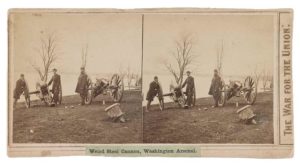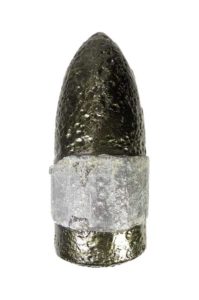A Canadian may have invented the Civil War’s best fieldpiece
[dropcap]A[/dropcap]ll sorts of new weapons were developed during the Civil War. Breechloading rifles, repeating rifles, and metal-cased ammunition all made their mark on battlefields. But such innovations were not limited to small arms. One inventor in particular, Norman Wiard, developed a number of cannons and boat howitzers that incorporated new ideas. Two fieldpieces that he developed, a 6-pounder rifle and a 12-pounder smoothbore, were particularly ingenious and innovative.
For example, Wiard applied the concept of interchangeable parts to the wheels of his gun carriages. Typical wheels were made as one unit, so if a wheel was damaged in battle or transit, it had to be replaced in its entirety. But Wiard’s wheels were made in a series of sections, with a set of spokes attached to a felloe, the arched pieces that made up the wheel’s circumference, which were held together by bolts and wedges. During a demonstration, Wiard handed an ax to an artillery officer and told him to destroy the wheels of his gun as fast as he could. The officer vigorously hacked away, but Wiard calmly unbolted the damaged portion of the wheel and replaced it with a spoke and felloe combination. Interchangeable parts for small arms were common during the Civil War, but no one had ever seen interchangeable wooden wheel parts.
Wiard, a foundry foreman originally from Ontario, Canada, came from a family of blacksmiths and metalworkers, and had been an inventor his whole life. Before the war, he obtained a patent for a steam-powered boat that could transport passengers and cargo over ice and snowdrifts. He also patented a steamship boiler that he sold to the U.S. and Japanese governments for $72,000 and $80,000, respectively. The boiler was placed on all 32 U.S. warships.
During the Civil War, Wiard served as the Union Army’s superintendent of ordnance stores, which placed him in intimate contact with the long arm of the battlefield. Frustrated that Federal forces were using “no less than nine different calibers of rifle and smooth-bore guns” he developed two unique cannons he believed would be viable alternatives to the North’s fieldpiece needs—a 2.6-inch 6-pounder rifle and a 4.62-inch smoothbore 12-pounder howitzer.

The barrels were made out of what he called “semi-steel,” a mixture of low-carbon cast iron and scrap steel instead of just iron. That meant the tubes could withstand the enormous pressure of 110,000 pounds per square inch—far in excess of any comparable field gun of the day. The 6-pounder rifle, for example could fire a shell 800 yards with only one ounce of powder, and up to 1,200 yards with two ounces. With a 12-ounce charge of powder, the rifle could fire a shell for four miles, and the shell would remain airborne for 34 seconds.
Wiard considered the physics of a cannon’s recoil. Objecting that carriage design had not changed much since the “French system of Gribeauval of 1765 ” and that many “axles are bent, broken, or twisted out and away from their fastenings” because of the gun’s tendency to recoil jarringly, Wiard designed his cannon carriage with a large flat steel plate on the bottom of the trail, with a perpendicular keel that would cut into the earth. The plate allowed the gun to slide freely when it recoiled, and the keel helped the gun recoil straight back. Wiard’s guns kicked back only an average of 20 inches—about half the recoil of a standard gun. The short distance, and the straight recoil, helped gunners return the cannon more quickly to its firing position and aim it for another shot.
The carriages also had unusually high, wide-spaced curved cheekpieces that rested directly on the axles and permitted Wiard’s cannon barrels to elevate to 35 degrees, much higher than the 5 and 10 degrees of elevation that most cannons could reach, allowing the howitzers to function like mortars. Another advantage was that both the 6-pounder and 12-pounder tubes fit on the same carriage.
Wiard realized that by the second year of the war more than 600 types of ammunition were being used for Union artillery pieces. Wanting to standardize and economize such projectiles, he designed his own. His 6-pounder shell, for example, contained only 10 ounces of fine gunpowder—rather than the commonly used coarse powder—and produced a higher shrapnel count of 40–60 pieces. A further benefit was that Wiard’s 6-pounder shell could be produced at less of a cost than any other rifled projectile, and 80 of those rounds could be carried on a single limber chest as opposed to only 40 for standard guns.

Firing canister from rifled guns had always been problematic, as centrifugal force caused the round to revolve with such velocity that the shot would spread in every direction after leaving the muzzle. But Wiard’s canister round consisted of two end-castings sandwiched around nine intermediate castings, with the shot completely encased within. A wire running internally through the length of the canister held the castings together, tightened at each end by bolts. The canister case was designed with rounded edges so that only a minute area touched the rifling when the gun was fired. Consequently, the charge would not expand into the rifling, distorting the shot’s pattern.
Despite the proven advantages of Wiard’s cannons and carriages, both Brig. Gen. James W. Ripley, chief of ordnance for the Union Army, and Brig. Gen. William F. Barry, chief of artillery for the Army of the Potomac, preferred the more traditional Parrott rifles and 3-inch ordnance rifles, meaning only 11 Union batteries would be equipped with Wiard cannons. All saw heavy action, however. On October 1, 1862, Brig. Gen. Franz Sigel wrote to Wiard that the “mobility, accuracy, and range…together with their remarkable facility for adjustment and repair on the field, were the subject of general remark among officers and men. In my judgement, the Wiard guns and equipment are superior to any field artillery I have ever seen in service.”
Captain A.C. Johnson of the 12th Ohio used his Wiard guns at the 1862 battles of McDowell, Cross Keys, White Sulphur Springs, and Second Bull Run. At Cross Keys he reported firing at least 600 rounds from his Wiards. One had the wood cover of the iron axle, but the gun continued to fire another 200 rounds with no additional damage to the axle or the carriage. Johnson considered the accuracy of the guns unequaled, and also appreciated their shorter recoil.
Although his guns were not widely accepted during the war, Wiard stayed in arms production after the conflict, and had a successful career. He died in 1896 at age 71. A number of Wiard guns survive and can be seen displayed on the battlefields at Fort Donelson, Shiloh, Fredericksburg, Pea Ridge, Petersburg, and at West Point.
Ronald D. Evans writes from Hillsborough, N.J. He retired after 38 years on Wall Street, and enjoys competitive black powder shooting and historical research.





